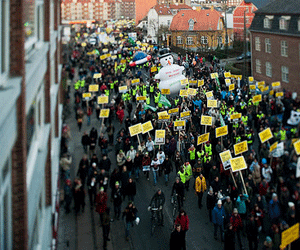Late Friday night, after the word had come down that the climate talks had ended in a five-way non-binding, unfair, and breathtakingly unambitious agreement between the US, China, India, Brazil, and South Africa, a crowd of demonstrators from around the world gathered at the Metro station outside the Bella Center. It was 1 a.m., and it was bitter cold, in several ways.
These were not angry anarchists. These were young people who had spent the last few years of their lives working hard to make this process work. They came from groups like Greenpeace and Avaaz and Energy Action and 350.org. They all had credentials to the conference, but almost none had been inside for days, ever since the UN decided to stop letting more than a token few NGOs into the hall. They had written position papers, advised small nations, organized email blasts, and now—at least for the moment—it had all come to an end, an end far worse than most had imagined.
Inside, the less important nations of the world were still “negotiating,” trying to decide whether to sign on to the text that the powers that be had left behind. It was an empty and impotent debate, resembling in its power more the “model UNs” that high schoolers conduct in civics classes across the U.S. It was also brave—an effort to say that the process of trying to solve the world’s problems will continue.
It’s unclear what that process will look like, or what role global civil society will play in a world where the power balance is now more nakedly obvious than it was before yesterday. China and the US have taken it upon themselves to solve the biggest problem we face, but both have set out profoundly unambitious plans for doing so. The best guess from the modelers at Climate Interactive was that the proposals various countries were making might yield a world 6 or 7 degrees Fahrenheit warmer, and with a carbon concentration of 770 ppm. That’s hot, and it’s why it felt cold down by that Metro station.











